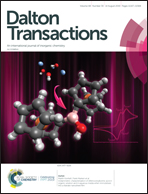Above room-temperature dielectric and nonlinear optical switching materials based on [(CH3)3S]2[MBr4] (M = Cd, Mn and Zn)†
Abstract
In this paper, three zero-dimensional organic–inorganic hybrid compounds [(CH3)3S]2[CdBr4] (1), [(CH3)3S]2[MnBr4] (2) and [(CH3)3S]2[ZnBr4] (3) were synthesized. The phase transition behavior of 1, 2 and 3 was well characterized by differential scanning calorimetry (DSC) and variable temperature single crystal diffraction measurements. The phase transition temperature of 1, 2 and 3 was at ca. 315 K in the heating process. The vigorous ordered–disordered reorientation and displacement motion of [(Me3)3S]+ and [MBr4]2− of 1, 2 and 3 induce the structural phase transition from the centrosymmetric (CS) space group Pnma to the non-centrosymmetric (NCS) space group P212121. The apparent second-harmonic generation (SHG) switching responses further confirm this CS to NCS symmetry breaking. Moreover, dielectric studies illustrate that 1, 2 and 3 display distinctly switchable dielectric behavior, revealing their potential application in dielectric switches. This finding suggests that sulfonium-based organic–inorganic hybrids can be used to build phase transition materials, broadening the way for exploring dielectric and nonlinear optical (NLO) switching materials.
![Graphical abstract: Above room-temperature dielectric and nonlinear optical switching materials based on [(CH3)3S]2[MBr4] (M = Cd, Mn and Zn)](/en/Image/Get?imageInfo.ImageType=GA&imageInfo.ImageIdentifier.ManuscriptID=C9DT02045D&imageInfo.ImageIdentifier.Year=2019)


 Please wait while we load your content...
Please wait while we load your content...